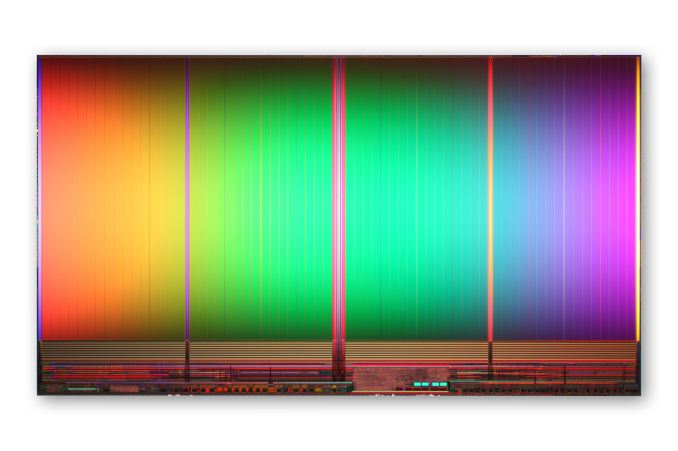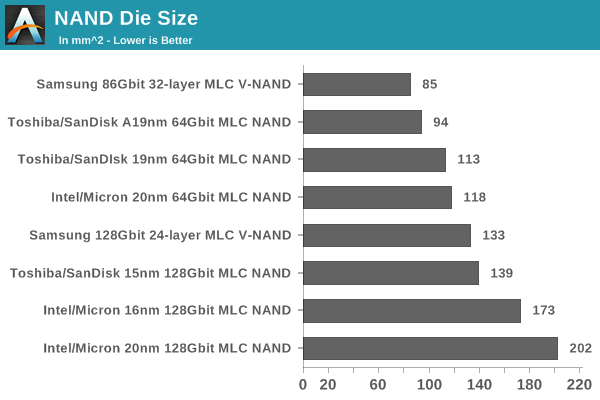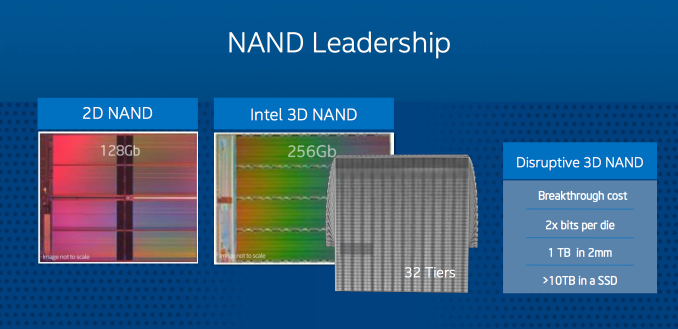Intel's 3D NAND to Ship in H2'15: 256Gbit Die & 32 Layers
by Kristian Vättö on November 25, 2014 5:20 AM EST
Last Thursday in its annual Investor Meeting Intel revealed the first details of its 3D NAND technology and announced that it will begin the shipments of 3D NAND in the second half of 2015. While Intel's investment in 3D NAND hasn't been a secret, the company has been relatively quiet about any specifics and the vital specs such as the number of layers and die capacity have remained unknown. In Thursday's webcast, Rob Crooke, Senior VP and General Manager of Intel's non-volatile memory group, disclosed that Intel's first generation 3D MLC NAND die will be 256Gbit (32GB) in capacity and will consist of 32 layers. The technology also enables a 384Gbit (48GB) TLC (3-bit-per-cell) die as we have learned over the years.
Intel claims that its 3D NAND is the most cost effective on the market and bases this on the fact that its die is 256Gbit whereas Samsung's is only up to 128Gbit at the moment. I'm not sure if I buy Intel's claim because while it's true that a higher capacity die results in higher array efficiency (i.e. peripheral circuitry takes less area), Samsung consciously went from a 24-layer 128Gbit MLC die to a 32-layer 86Gbit MLC die. In other words, Samsung could have upped the die capacity to ~170Gbit by just adding the extra layers, but the company chose to go with a smaller die instead. Smaller capacity dies have advantages in performance (higher parallelism) and applicability because eMMC/microSD devices have very strict die size constraints, so that might be a part of the reason why Samsung's strategy is so different from Intel's and Micron's.

As the graph above shows, Intel's/Micron's NAND dies have historically been larger than the competitors', so the die capacity alone isn't enough to dictate whether Intel's 3D NAND is more cost efficient than Samsung, especially because both have 32 layers. Unlike Samsung, Intel didn't reveal the lithography that is used to manufacture the 3D NAND, but I would say it's safe to assume that the lithography is in the order of 30nm or 40nm because the whole idea of 3D NAND is to move away from multi-patterning to cut costs and with today's technology the smallest pitch of single-patterning is somewhere between 30nm and 40nm. Either way, it will be very interesting to see how Intel's 3D NAND stacks up against Samsung's because there are also some structural differences that affect the production cost as well as performance and endurance, but I'll save the structural analysis for a future article.
Intel said that 3D NAND technology will enable +10TB SSDs in the 'next couple of years', but it wasn't clear whether that is with first generation 3D NAND or some later generation with more layers and higher die capacity. Currently Intel's lineup tops out at 2TB (P3700 & P3600) with a 128Gbit die, so the 256Gbit die alone isn't enough to bring the capacities above 10TB. With effective controller development it should certainly be possible to build a 10TB SSD with a 256Gbit die, although I'm still inclined to believe that Mr. Crooke was referring to second or third generation 3D NAND with his statement.
Similar to Intel's previous NAND efforts, 3D NAND has been jointly developed with Micron and will most likely be manufactured in the co-owned Utah plant as Intel sold its share in other fabs a couple of years ago. Interestingly enough, Mr. Crooke said that they also have the ability to bring 3D NAND production to an Intel fab, although to me that sounded more like a statement of technological possibility rather than a hint of future strategy. I wouldn't rule it out, though, but like Mr. Crooke said in the Q&A, Intel needs to have significant competitive advantage for it to make sense. In the past Intel's NAND technologies have generally been slightly ahead of the rest of the industry, but at least as of now Intel doesn't seem to have any substantial advantage in 3D NAND technology as Samsung is already shipping a 32-layer die and will likely ship a 48-layer die before Intel ships its 32-layer product.
All in all, we'll likely get more crumbs of information as the second half of 2015 gets closer. Given Intel's recent SSD strategy, I expect 3D NAND to first find its way to enterprise-class SSDs, but we'll see soon enough.












58 Comments
View All Comments
mapesdhs - Tuesday, November 25, 2014 - link
Not true, SSD prices for 240GB/256GB capacities were totally stuck for over a year at one
point (from about Feb/13 onwards), infact they went *up* shortly after autumn 2012. For
a brief time it looked like prices would go below 100 UKP equivalent for a 256GB model,
but in early 2013 that all changed. Nothing moved until Crucial kicked everyone else up
the butt with the MX100 and M500. I was tracking pricing on behalf of some industrial
users, the static or rising prices were all too obvious. The most likely reason is proverbial
supply & demand: why sell them cheaper when they're selling just fine at existing or even
higher prices? One particular retailer in the UK did a special on the Samsung 830, selling
hundreds of them in just a couple of weeks for around 125 UKP each. I'm sure this
helped convinced Samsung & others that there was simply no need to lower the
pricing any further, the demand was just fine at existing levels back then (135+ for a
mainstream model like the 830). When the 840 came out, the 830 vanished and
pricing went _up_ to around 145 for a while.
So, in other words, whatever an SSD *could* be sold for based on its production cost,
if the demand is strong, the end consumer pricing will be higher. It needs a vendor
willing to rock the boat to really make things change.
Today the 840 EVO 256GB is around 95 UKP in the UK, but when one considers
the 830 256GB was 125 UKP in late 2012, overall that's not really a huge difference
in 2 years.
Ian.
melgross - Tuesday, November 25, 2014 - link
It always happens that prices stutter. The same happens to RAM. Look at where that is now. It's much worse!You need to look at an average trend line. When you do, you'll se the dropping prices over time, and the increased capacity. This is dependent on the memory manufacturers. When they come out with bigger chips, then we see bigger drives, and lowered pricing.
It also depends on our hers. If people aren't buying big drives because of cost, it will take longer.
earl colby pottinger - Saturday, December 6, 2014 - link
That is weird because I bought a 240GB drive on Black Friday for $109 and note that was in Canadian dollars which I think were worth $0.88 American at the time.It is in the computer I am using right now!
earl colby pottinger - Saturday, December 6, 2014 - link
Ouch, I just looked up the exchange rate, you guys are getting hosed.$109 CDN => 61.21 UKP! for a 240GB drive.
melgross - Tuesday, November 25, 2014 - link
That's not true. Capacity has increased, and prices have fallen. It used to be that 500GB drives were over $1,000, not all that long ago. Then they dropped to $600, and now they are below $300.In turn, 1TB drives were well over $1,000 when the 500's were at $600, now you can get them for less than $500, if you look around.
Sheesh! I remember when 32GB models were over $3,000, a few years ago.
odedia - Tuesday, November 25, 2014 - link
Regarding the use of an Intel fab for the SSD production - this may very well be done in Israel.Intel in Kiryat Gat, Israel, bought Micron, which has a plant right next to the Intel one. At first it was not clear what would happen to the plant and even to Intel's presence in Israel as a whole, but a few weeks ago, Intel signed a long-term deal with the Ministry of Finance, getting nice tax breaks while in return promising to stay for another 20 years or so. It seems like the perfect place for such a production facility.
Sources:
http://www.haaretz.com/business/1.549524
http://www.breakingisraelnews.com/22008/israel-int...
bhd2 - Tuesday, November 25, 2014 - link
Micron on 3D NAND flash at the UBS Tech conference on Nov 18;Steven Chin
... But to make a transition maybe we could talk a little bit about NAND Flash opportunity you brought up the Singapore fab, you transition that from DRAM to NAND Flash. Sound like that will be the initial 3D NAND fab, can you just remind us what the timing is for 3D NAND roll out, is Singapore actually the primary location where you likely do 3D NAND, maybe just share some thoughts and let's around --
Kipp Bedard
You bet. Yes. And Singapore will be initially the 3D NAND opportunity for us. Timing wise, we are shipping samples here in Q4. And we've always maintained that the ramp probably is going to take longer from an industry standpoint than people were expecting, these transitions are difficult. It is new technology.
http://seekingalpha.com/article/2693885-micron-tec...
I would guess that the first Intel samples are out of Singapore too!
hojnikb - Tuesday, November 25, 2014 - link
Looking at the odd size of samsungs 3D flash... Is it possible that this is designed to actually be 128Gbit TLC, but then simulated down to MLC (to up the speed and endurance). It would certanly explain odd size.bhd2 - Tuesday, November 25, 2014 - link
Now that Samsung has launched their 128 Gb TLC 3D NAND, I think that is exactly the case.Hulk - Tuesday, November 25, 2014 - link
Intel still loves to throw around that "10" number.Remember the 10GHz P4's we'd be using by 5 years ago?
Yeah, like one poster wrote. How about affordable 4GB drives next year or 6GHz processors next year?